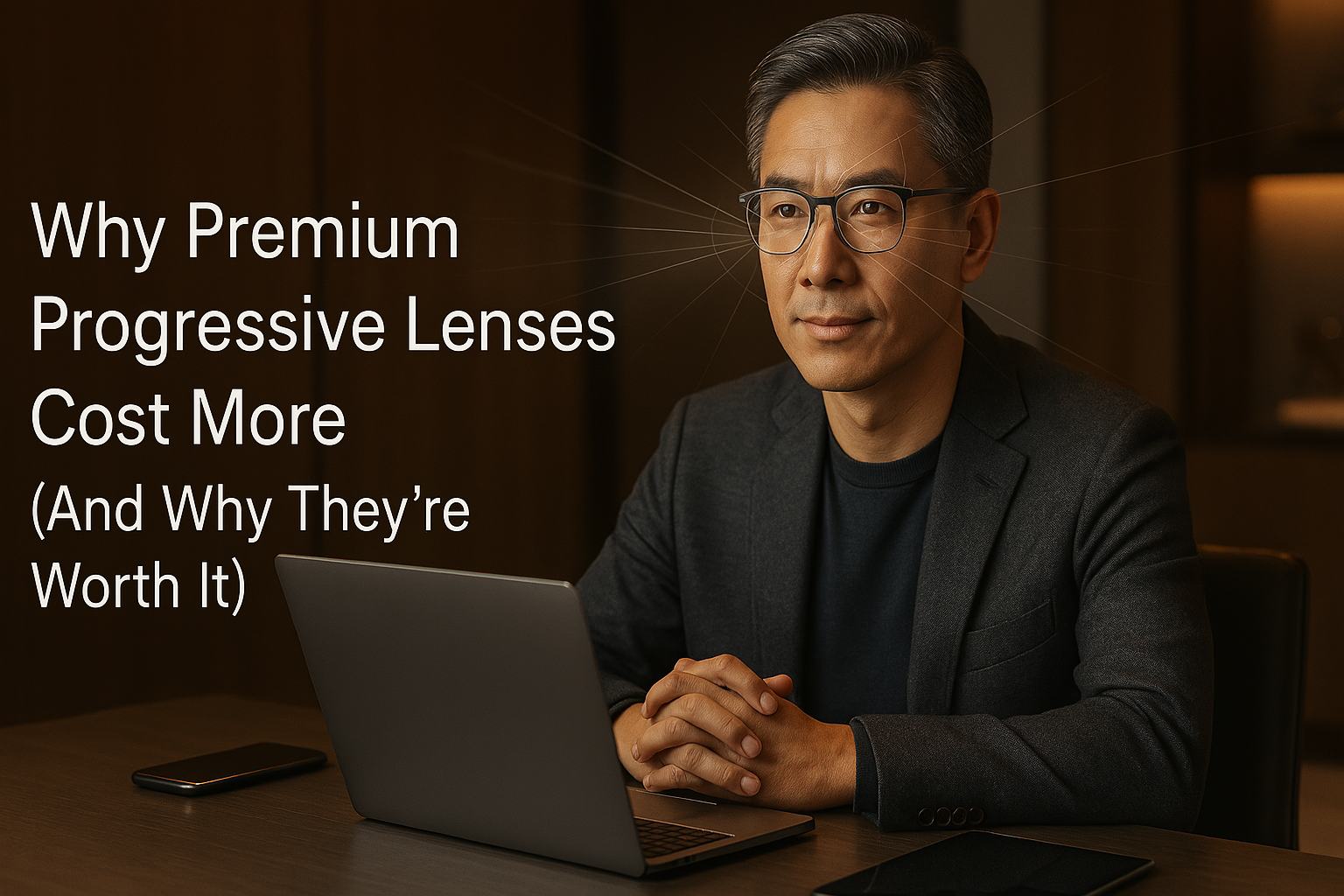Baby Bonus Accepted Here : )

We get it — you walk into an optical shop, look at the price of premium progressive lenses, and think: “That’s more than my iPad.” Or “Wait, didn’t I pay less for my laptop?”
Totally fair.
But here’s the truth: progressive lenses aren’t just pieces of plastic. They’re miniature feats of optical engineering — custom-designed for your unique eyes, daily habits, and frame of choice. And unlike your phone or laptop, which help you look at things, your glasses help you see the world — all day, every day.
Let’s break it down.
Premium progressive lenses are not “one-size-fits-all.” Each pair is customized to your prescription, frame fit, and even how you tilt your head or hold your phone. Behind the scenes? Complex mathematical calculations, biometric measurements, and micro-precision engineering.
Unlike single-vision lenses, progressives offer seamless transitions from near to intermediate to far — all in one lens. Achieving that smooth shift (without distortion or dizziness) takes serious optical wizardry.
Many high-end progressives use freeform surfacing — where every single lens is individually crafted by computer-controlled tools, down to sub-micron accuracy. It’s like a 3D-printed lens made just for your eyes.
🧠 Tech Talk for the Curious: Your lenses are basically microprocessors for your eyes, calculating and delivering vision correction in real time.
Companies like Hoya, Zeiss, and Essilor spend decades and millions in R&D to improve vision clarity, reduce side blur, and make your experience seamless. These aren't off-the-shelf products — they’re patented, performance-driven visual tools.
You might hear terms like wavefront-guided design, binocular harmonization, or anti-fatigue zones — these are real technologies, tested and refined across years of trials.
Unlike your phone, where millions of units help spread out R&D costs, eyewear is niche. Each lens carries more of that innovation cost — but delivers unmatched results.
We’re not talking basic plastic here. Premium progressives use:
High-index materials – thinner, lighter, and more durable
Advanced coatings – scratch-resistant, anti-glare, anti-smudge
Blue-light filters – to protect your eyes from screens
Each lens is polished and surfaced with machines that can cost more than a sports car — all to ensure you get crisp, comfortable vision from edge to edge.
You’re not just paying for the lens. You’re paying for layers of invisible comfort:
Anti-reflective coatings to reduce night glare and reflections
Blue-light protection to reduce digital eye strain
Scratch-resistance that makes your lenses last longer
These coatings are applied in ultra-clean, lab-controlled environments — and every layer adds to your daily visual comfort.
Ever tried progressives and felt dizzy? That’s often because they weren’t properly fitted.
A professional fitting involves more than just checking your prescription. It includes:
Precise measurements of pupillary distance
Frame alignment including pantoscopic tilt and vertex distance
Lifestyle discussion to match the lens to your needs (e.g. desk work, meetings, driving)
This human expertise ensures your lenses don’t just work — they work for you.
You’ve probably seen the ads: “Free progressives with frame purchase!” Sounds tempting, right?
Here’s the catch: those are often entry-level, outdated designs — with narrow clear zones, more blur at the edges, and low adaptability. Think of them like budget earbuds vs. studio-grade headphones.
They work, yes. But for long hours of screen time, driving, meetings, or reading? Your eyes deserve better.
Think about this:
You wear your lenses 16+ hours a day
You replace them maybe once every 2–3 years
They support your vision while working, driving, reading, and relaxing
That’s more wear time than your laptop, tablet, or phone. Yet we don’t blink at paying $2,000 for a new phone every other year — because it’s “worth it.”
But your glasses are the one tool that actually lets you see all of that.
Premium progressive lenses are like a bespoke suit — tailored to your body, built to last, designed for comfort.
Budget lenses? More like fast fashion. They’ll fit, sort of. But wear them all day, every day — and you’ll feel the difference.
We’re not just selling lenses. We’re crafting visual performance tools for the modern man — someone who values precision, quality, and smart investment.
At our clinic, you’ll experience:
Comprehensive eye exams using advanced diagnostic tech
Precision measurements for biometric alignment
Expert recommendations tailored to your lifestyle and screen time
Access to the world’s top lens brands, fitted with care
And most importantly — we take the time to get it right.
Book an appointment to explore what premium progressive lenses can do for your vision, your comfort, and your daily performance.
Let’s help you see better — and live sharper.
Comments will be approved before showing up.

Worried your child’s myopia keeps getting worse each year despite wearing glasses? Discover how myopia control lenses like MiYOSMART, Stellest, and ZEISS MyoCare—available in Singapore—can help slow progression and protect long-term vision. Learn how to choose the right option for your child, based on clinical evidence and expert guidance.